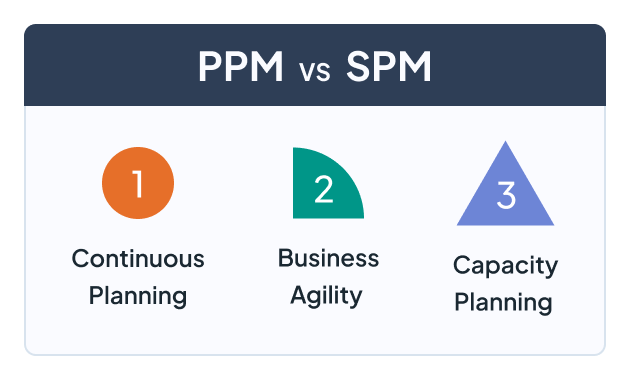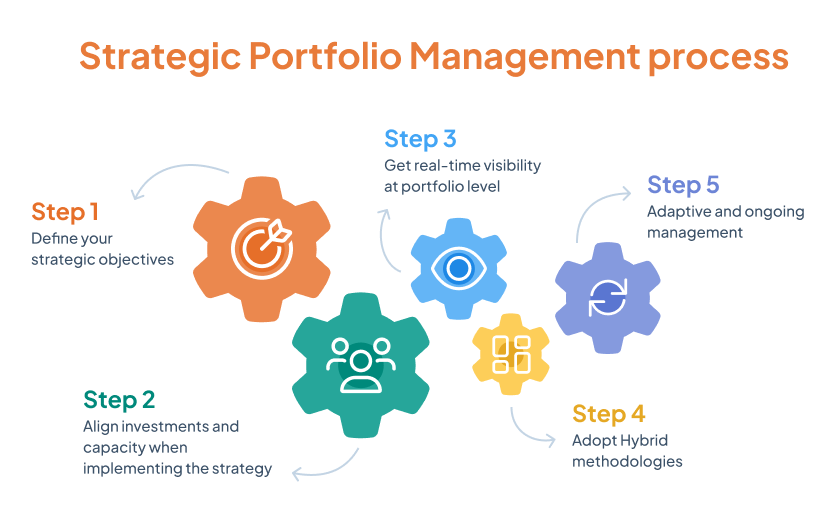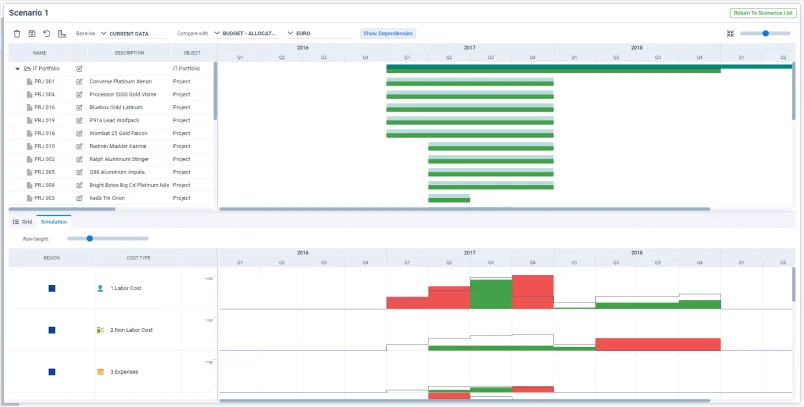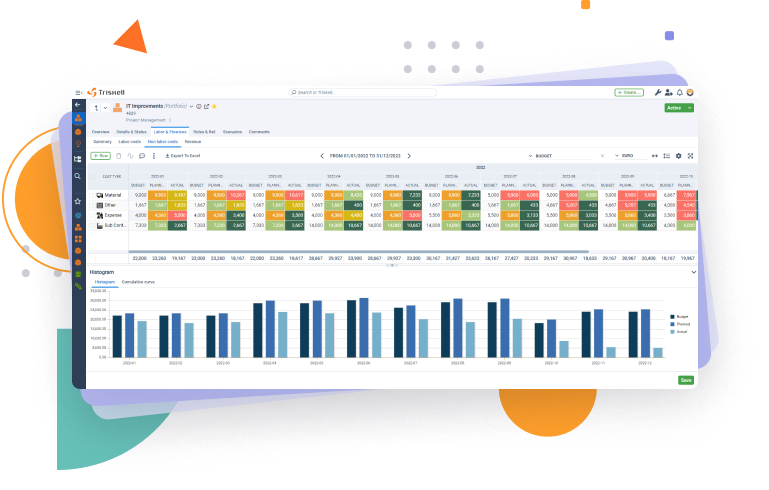A 5-step strategic portfolio management process: a winning strategy to business success

Are you struggling to connect projects and programs with the strategic objectives of your organization? Don’t you have visibility on objectives, which limits your ability to undertake resource management or financial management efficiently? Effective project portfolio management is useless if it does not deliver business outcomes. And how to address it? By embracing Strategic Portfolio Management, the new PPM era.
In this post we explain the key components of the Strategic Portfolio Management process. Starting from the base, which is the definition of strategic objectives, we will unpack all the components of a process that will take your PPM to the next level.
What is Strategic Portfolio Management: a brief introduction
But before going deeper into this, let’s introduce the concept of Strategic Portfolio Management (SPM), and what are the main differences with Project Portfolio Management (PPM).
As Gartner explains, Strategic Portfolio Management (SPM) is “a set of business capabilities, processes and supporting portfolio management technologies” in order to create “a portfolio of strategic options that focus an organization’s finite resources” and with which to execute business strategy across the corporation.

STRATEGIC PORTFOLIO MANAGEMENT
Streamline portfolio management and boost efficiency
Discover Triskell Software’s Strategic Portfolio Management capabilities.
One of the major challenges for organizations is to prioritize projects, products and programs according to their mission and strategic vision. And it is an issue mainly for two reasons:
- Strategic objectives are not clear enough, either because they are not well defined or because they have not been communicated to all stakeholders involved in strategy execution.
- There is no visibility over all the information artifacts and processes that make up project portfolio management. This can lead to information silos in relevant topics such as Capacity Planning, Financial Management or Risk Management. Silos that, if not eliminated, will cause your PPM efforts to fail to produce the expected business results.
Establish a governance structure that includes all stakeholders and communication protocols for each of them
At the end of the day, Strategic Portfolio Management consists of implementing a series of processes and tools that will facilitate decision making in matters such as:
- Prioritization or cancellation of projects based on whether or not they are aligned with the objectives.
- Plan capacity and resource management more efficiently, especially for those projects and programs that are of vital importance to the company.
- Open or close the flow of investments in the organization’s portfolios based on their relevance to the business.
Strategic Portfolio Management vs Project Portfolio Management: what´s the difference?
Project Portfolio Management has always been linked to Project Management. In other words, PPM, over the last 25 years, has focused on completing projects within the agreed deadlines and budgets, always prioritizing those initiatives that deliver the highest value in the long term and in the shortest possible time.
Due to the proliferation of applications that were defined as PPM tools, the concept of Strategic Portfolio Management emerged. This is a term with which PPM market analysts recognize all those solutions that focus on enterprise-wide alignment and adaptation to strategic planning and execution.
Therefore, there are 3 main differences between Strategic Portfolio Management and Project Portfolio Management:

- Continuous planning: Strategic Portfolio Management focuses on continuous planning and its monitoring. In this way, business outcomes can be linked to the different project portfolios of the organization in the medium and long term.
- Business agility: the need to shorten time-to-market and maximize market opportunities makes it unfeasible a project portfolio management disconnected from the company’s mission and vision. Strategic Portfolio Management provides a 360º vision of strategic planning and execution and makes organizations more agile in prioritizing initiatives or adapting to changes in strategy.
- Maximize capacity and resource usage: The Strategic Portfolio Management process provides organizations with the appropriate processes and tools to assess the priority of projects given their limited capacity and resources. It thus contributes to more efficient resource management and capacity planning.
Optimize your PPM processes and achieve strategic alignment
Request a demo of Triskell and see how it can help you streamline processes, make data-driven decisions, and achieve business success.
Designing a successful Strategic Portfolio Management process
This change of approach, however, is not easy and requires a detailed process. PMOs have to manage an increasing number of projects and programs with increasingly limited resources and capabilities. They also need to prove the value they bring to the corporation in the eyes of Executives and Senior Management. And, for this, the most effective way is to create a Strategic Portfolio Management process that links the different projects, programs and products to be managed with corporate objectives.
To this end, these are the 5 steps to design a Strategic Portfolio Management process that contributes to business success:
- Define your strategic objectives.
- Align investments and capacity when implementing the strategy.
- Get real-time visibility at portfolio level.
- Adopt Hybrid methodologies when delivering the work.
- Adaptive and ongoing management.
We go into more detail on each of the steps of the process below.

Step 1: Define your strategic objectives
To set the foundations of the process, it is essential to start with the basics: to define your strategic objectives. These objectives will ultimately guide the PMO in selecting and prioritizing the projects that will add the most value to the business.
Remember that it is very important to have traceability between the overall objectives of the organization and the project outcomes, as well as to efficiently communicate the strategy to all stakeholders involved in the strategy planning and execution. It is the only way to get the whole company on the same page.
A framework such as OKR can help you establish this connection between objectives, project portfolio prioritization and outcomes. It will help you to monitor in real time if you are achieving the expected results and to pivot or reprioritize your project portfolios according to changing business needs.
WHITE PAPER
Strategic Planning: From scrap head to moon shot
Step 2: Align investments and capacity when implementing the strategy
Once you draw up a roadmap in which you can visualize the objectives and how you will achieve them, you pave the way for better decision making in areas such as Budget Management, Capacity Planning or Resource Management.
By aligning investments with strategy execution, you are assured that the most relevant projects to your strategy will be properly financed. The same applies to Capacity Planning: your most valuable resources will be involved in the most important projects, while you detect resource constraints earlier.
Use criteria such as risk, ROI or strategy alignment to prioritize project portfolios
This will have a positive impact on project and product portfolios that are most relevant to the business, as blocking points and bottlenecks in resources or funds allocation will be reduced. However, this part of the process requires constant monitoring and review, so you should:
- Centralize all your Demand Management processes to have complete visibility on all work to be delivered and to be able to select and prioritize initiatives in real time.
- Review every 3 to 6 months the priority of deliverables: Organizational objectives change at a dizzying pace. This means that the priority of each project portfolio must be constantly reviewed to ensure that it remains aligned with objectives. And, consequently, capacity planning and budget management must also be reviewed from time to time to ensure that they remain aligned with the strategy.

Step 3: Get real-time visibility at portfolio level
For a successful implementation of the Strategic Portfolio Management process, information silos must be broken down. Tools and processes must be established to ensure the traceability between objectives – portfolio prioritization – results.
Whether it is because project portfolios and strategic planning are still managed with spreadsheets, or because many PPM solutions have failed to adapt to the new reality of organizations, the fact is that many organizations today do not have the tools to connect strategy, execution and business benefits.
Now more than ever it is necessary to have a PPM software with SPM functionalities, as they will be your ally to face the challenges you will encounter when implementing the Strategic Portfolio Management process. For example:
- Plan strategy and operations from one single place.
- Allocate resources and funds according to objectives./li>
- Prioritize the most profitable projects and initiatives for the business.
- Break down informational silos.
- Etc.
PPM SOFTWARE CHECKLIST
A Comprehensive buyer’s checklist for PPM Software
Use this quick checklist to compare potential modern PPM solutions in order to pick the best one for your organization.
Step 4: Adopt Hybrid methodologies when delivering the work
Related to the previous point, another weakness of most PPM software is that they are very rigid when it comes to pivoting between different Project Management methodologies. The objective of Strategic Portfolio Management is to accelerate the delivery of business value with whatever working methodology. Therefore, this process allows the use of agile, hybrid or waterfall methodologies.
This would mean selecting from a single PPM platform the work methodology that best suits each project according to the complexity, risks and resources needed to carry it out. For example, complex projects with a high level of uncertainty may benefit from an agile approach, while simpler projects may be better suited to a traditional approach.
Only a very few PPM tools have this flexibility to pivot from one methodology to another on the same platform. Having it would help to connect the work delivered with the business objectives, as well as help to accelerate the commercialization of our products and services, or to meet the expectations of customers and stakeholders.
WHITE PAPER
Interfacing between Linear Waterfall and Agile Approaches
Step 5: Adaptive and ongoing management
Last but not least, Strategic Portfolio Management is a process of continuous improvement. And even more so in this highly competitive environment, in which companies must be able to continually adapt to economic changes in order to be resilient and remain competitive in their markets.
This involves periodically reviewing the strategic planning (objectives, OKRs, decision-making criteria), as well as the performance and risks of each of the project portfolios. And, based on your analysis, optimize aspects such as Capacity Planning or Budget Management, as mentioned in point 2 above.
Adaptability. This is the key idea that you have to stick with. Adaptive Portfolio Management will give your organization the flexibility to address changes in strategy execution without compromising the performance and results of your project portfolios, and is a key element for efficient Strategic Portfolio Management.
Put in place performance metrics that measure progress toward strategic objectives
Conclusion: Strategic Portfolio Management, welcome to the new era of PPM
In conclusion, Strategic Portfolio Management has become an essential tool for companies looking to connect their strategy with execution. The 5 steps we have detailed in this article provide a clear and practical roadmap for designing and executing a successful Strategic Portfolio Management process.
It should be noted that, in order to implement this process, it is essential to have PPM tools with Strategic Portfolio Management capabilities. This will allow you to get a clear, real-time view of the strategy and all your project and product portfolios, helping companies to make informed decisions and align investment with strategic objectives.
If you want to learn more about Triskell’s Strategic Portfolio Management platform solutions, don’t hesitate to request a demo right now.
SUBSCRIBE TO OUR NEWSLETTER
Get stories like this in your inbox
Request a demo of Triskell Software
Want to learn more? Request a free demo of Triskell Software and you will discover the PPM software that best suits your business needs.

FAQs about Strategic Portfolio Management process
How can I get started with implementing a strategic portfolio management process?
Here are some initial steps to establish an Strategic Portfolio Management (SPM) process:
- Gain buy-in from senior leadership: Secure leadership support to ensure SPM has the necessary authority and resources.
- Identify key stakeholders: Involve relevant stakeholders across departments to ensure a holistic view of the portfolio.
- Define clear decision-making criteria: Establish criteria for project selection and prioritization based on strategic alignment.
- Choose appropriate tools and technologies: Consider PPM software solutions that facilitate portfolio visualization, analysis, and collaboration.
How does strategic portfolio management differ from traditional project management?
While project management focuses on individual project execution, SPM takes a broader view. It considers the entire portfolio of projects, ensuring alignment with strategic goals and optimal resource allocation across all initiatives. SPM helps organizations make strategic choices about which projects to pursue based on their potential contribution to the overall vision.
How can I ensure my strategic objectives are clear and measurable?
Developing SMART objectives (Specific, Measurable, Achievable, Relevant, and Time-bound) provides clarity and facilitates measurement:
- Specific: Clearly define what you want to achieve with each objective.
- Measurable: Establish metrics to track progress towards your objectives.
- Achievable: Set realistic yet ambitious goals for your projects.
- Relevant: Align objectives with your overall organizational strategy.
- Time-bound: Define a timeframe for achieving each objective.
How can I overcome common challenges associated with strategic portfolio management?
Here are some strategies to address common SPM challenges:
- Resistance to change: Address concerns and provide clear communication about the benefits of SPM for better adoption.
- Lack of clear strategic objectives: Clearly define strategic goals to guide portfolio decisions and ensure alignment.
- Data quality and integration issues: Implement processes to ensure data accuracy and seamless integration between different systems.
- Limited portfolio visibility: Invest in PPM tools that provide a comprehensive view of your entire project portfolio.
